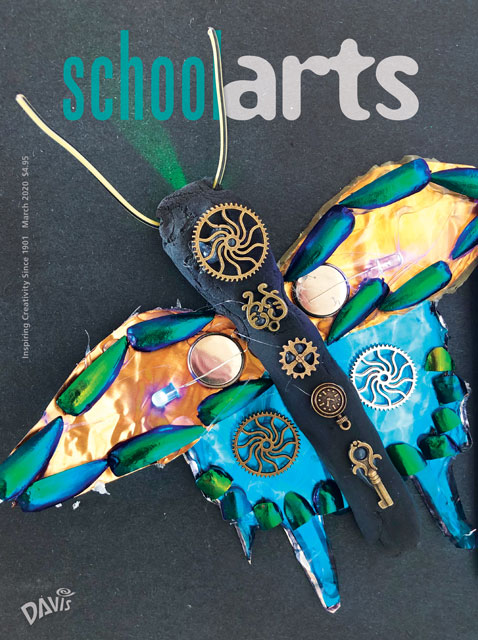.jpg) |
| Two colorful class-painted rain barrels. |
To my happy surprise, they did, and they had sponsorships for schools so we wouldn’t have to pay the entrance fee! The first rain barrels I used were provided by the sponsorship, so they were already set up for use with a water system. I just taped and covered all of the hardware where I didn’t want paint to go, such as the collection screen and water spout. Now that I’m doing this project individually, we follow the same steps in painting the barrels, but we have to add the hardware after the painting and sealing is finished.
The Design Process
To start the project, I talk to students a little about the water system and also how we can collect rainwater to water our gardens while conserving it. Next, we brainstorm, sketch ideas, and discuss them as a class. The location of where the rain barrel will go often becomes an inspiration. For example, one time a rain barrel was going to our school farm, and students had the idea of painting flowers and subject matter related to nature. When the barrel was going to an aquaponics greenhouse location, the imagery of fish and water were common themes.
Once our theme is chosen, we use the class smartboard to add our ideas to a blank template. The template has two blank barrels side by side to represent different angles of the barrel. Each class designs its own barrels and then all of the classes vote on one final design.
The Painting Process
The process of creating the rain barrel involves many steps. In addition to the design, there is also preparation, painting, and finishing that involves each class. These steps include sanding and roughing up the barrel surface with sandpaper, and washing them to ensure that all of the dust and oils are off. The barrel is primed with gesso. I sketch out the design onto the barrel and students paint it with acrylics. After the barrel has been painted and decorated, it is varnished with multiple layers of sealant.
Logistics
Several classes work on the design through different parts of the week. As the work progresses, classes have time to add smaller details. Often, it doesn’t turn out exactly as the initial plan shows. I use this situation to talk about how art can change as we collaborate and as the artwork progresses. (As technology becomes more available in my school, I plan to incorporate a virtual discussion so classes can have more interaction throughout the entire process.)
My classes are all adapted art classes—each has its own unique approach to participating in the process. Some classes have a main focus of using wide brushstrokes or more of a textural focus, and these classes can work on the background or large areas. If students have difficulty participating in this way, they may contribute by creating imagery with their handprints. Advanced students can focus on smaller or more technical details.
Reflections
I find students can be more open to participating when they know others will be helping. I’ve also noticed how many of them enjoy working on a surface that’s different from normal drawing paper. After the project is complete, I see a lot of pride in my students knowing that they all contributed.
Keriann Kirkeng is an art teacher at Genesee Lake School in Oconomowoc, Wisconsin.
View this article in the digital edition.


.jpg)
